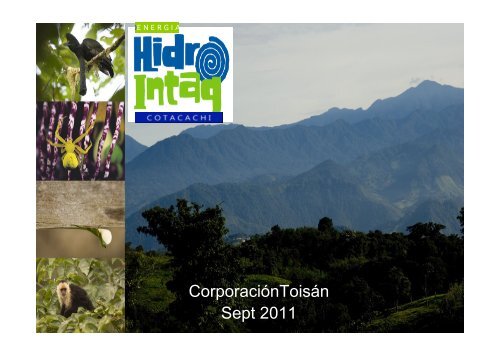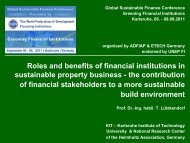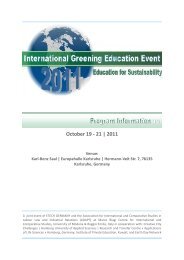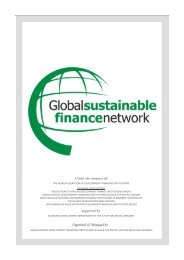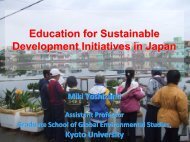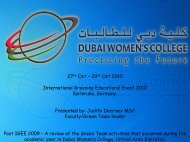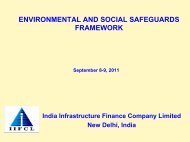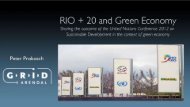Hydro Intag – A case of green project finance in Ecuador
Hydro Intag – A case of green project finance in Ecuador
Hydro Intag – A case of green project finance in Ecuador
You also want an ePaper? Increase the reach of your titles
YUMPU automatically turns print PDFs into web optimized ePapers that Google loves.
E C OE N E R G I A<br />
CorporaciónToisán<br />
Sept 2011
Contents:<br />
1. <strong>Intag</strong>’s socio-environmental context<br />
2. Susta<strong>in</strong>able economic alternatives for the<br />
management and development <strong>of</strong> the river <strong>Intag</strong>’s<br />
bas<strong>in</strong><br />
3. The <strong>project</strong> Hidro<strong>in</strong>tag<br />
4. Proposal for implementation 2011 - 2015
Orig<strong>in</strong>al vegetation <strong>of</strong> <strong>Ecuador</strong> Remnant vegetation <strong>in</strong><br />
1996<br />
<strong>Intag</strong><br />
E C OE N E R G I A
Environmental importance:<br />
600 Km2 <strong>of</strong> primary forest.<br />
420 Km2 under protection<br />
E C OE N E R G I A
<strong>Hydro</strong>logical importance:<br />
25 water bas<strong>in</strong>s.<br />
E C OE N E R G I A
Biological importance <strong>of</strong> <strong>Intag</strong>. Ecoregion “Choco<strong>–</strong>Tropical Andes”<br />
• “Hot Spot”: one <strong>of</strong> the places with the<br />
highest biodiversity and endemism on<br />
earth<br />
• Refuge <strong>of</strong> many animals <strong>in</strong> danger <strong>of</strong><br />
ext<strong>in</strong>ction (Andean bear, spider monkey,<br />
jaguar)<br />
• Highly endangered<br />
INTAG
Socio-economic importance<br />
• 17.000 Inhabitants<br />
• Agricultural economy:<br />
• Gra<strong>in</strong>s: corn and beans<br />
• Livestock farm<strong>in</strong>g<br />
• Sugar Cane<br />
à Food sovereignty<br />
Unsatisfied needs<br />
- Communications - Roads<br />
- Education <strong>–</strong> Health care
Threats<br />
- degradation <strong>of</strong> ecosystems<br />
- erosion, loss <strong>of</strong> soil fertility<br />
- loss <strong>of</strong> biodiversity<br />
- ext<strong>in</strong>ction <strong>of</strong> species<br />
- low agricultural productivity<br />
- migration and poverty<br />
- expansion <strong>of</strong> agricultural<br />
border<br />
- conventional agriculture<br />
- Slash and burn practices /<br />
high usage <strong>of</strong><br />
agrochemicals<br />
- <strong>in</strong>vasions on forest heritage<br />
and protected forests<br />
- deforestation
large-scale m<strong>in</strong><strong>in</strong>g<br />
1980-1985: first explorations by<br />
the Belgium cooperation CTB<br />
1990-1997: exploration by the<br />
Japanese cooperation JICA<br />
1996: Environmental Impact<br />
Assessment (EIA)<br />
1.997 expulsion <strong>of</strong> Mitsubishi<br />
2003: illegal concession for<br />
Ascendant Copper Canada<br />
2008: M<strong>in</strong><strong>in</strong>g mandate - National<br />
Assembly<br />
Retreat <strong>of</strong> Ascendant Copper
The m<strong>in</strong><strong>in</strong>g <strong>project</strong> accord<strong>in</strong>g to the EIA <strong>of</strong> JICA<br />
• 318 million tons <strong>of</strong> low-grade ore<br />
• 0.7% copper (2.2 million tons <strong>of</strong> pure copper)<br />
• per each metric ton <strong>of</strong> extracted material, 7 Kg copper will be obta<strong>in</strong>ed<br />
• residues: 315 million tons <strong>of</strong> material
Achievements <strong>of</strong> the social resistance process<br />
• Pacific resistance aga<strong>in</strong>st<br />
human rights violations<br />
• Regional environmental<br />
conscience<br />
• Retreat <strong>of</strong> 2 mult<strong>in</strong>ational<br />
m<strong>in</strong><strong>in</strong>g companies<br />
• withdrawal <strong>of</strong> 23 illegal<br />
m<strong>in</strong><strong>in</strong>g concessions<br />
• Legal actions aga<strong>in</strong>st the<br />
TSX<br />
• National debate about<br />
extractive <strong>in</strong>dustries
From resistance to suggestions <strong>–</strong> social organizational process<br />
CorporaciónToisán • Asociación de Caficultores Río <strong>Intag</strong> -<br />
AACRI<br />
• Defensa y Conservación Ecológica de<br />
<strong>Intag</strong> - DECOIN<br />
• Cord<strong>in</strong>adora de Mujeres de <strong>Intag</strong> - CMI<br />
• Corporación de Talleres del Gran Valle de<br />
Manduriacos - CTGV<br />
• Red Ecoturística de <strong>Intag</strong> - REI<br />
• Corporación de productores de granos<br />
<strong>Intag</strong> Sustentable - CORPAIS<br />
• Corporación de productores de lácteos <strong>Intag</strong> Leche - CORPIL<br />
• Asociación de Campes<strong>in</strong>os Agroecológicos de <strong>Intag</strong> - ACAI<br />
• Cooperativa de crédito asociativo - CORDESPRO - INTAG<br />
• Red de Bosques Comunitarios de <strong>Intag</strong><br />
• Casa Palabra y Pueblo
Answers and proposals <strong>of</strong> the organized civil society<br />
• Agro forestry organic<br />
c<strong>of</strong>fee<br />
• Dairy production <strong>in</strong> silvo<br />
pastures<br />
• Production <strong>of</strong> traditional<br />
local gra<strong>in</strong><br />
• Agro <strong>in</strong>dustries &<br />
handicrafts<br />
150 ton/year<br />
4.000 lit/day<br />
200 ton /year<br />
180.000 $/year<br />
• Ecotourism 4.000 pas/year<br />
• Local micr<strong>of</strong><strong>in</strong>ance<br />
• Watershed conservation<br />
150.000 $/year<br />
45 reserves<br />
E C OE N E R G I A
Projects<br />
10 year goals<br />
Amount Employment Incomes $/year<br />
Organic c<strong>of</strong>fee 3.375 ton/year 3.000 11.250.000<br />
Dairy production 45.000 lit/day 1.000 4.106.250<br />
Production <strong>of</strong> traditional<br />
local gra<strong>in</strong><br />
Agro <strong>in</strong>dustries and<br />
handicrafts<br />
1.350 ton/year 3.500 1.050.000<br />
450.000 $/year 200 450.000<br />
Ecotourism 30.000 pass/year 250 1.350.000<br />
Local micr<strong>of</strong><strong>in</strong>ance 5.000.000 $/year 25 600.000<br />
Watershed conservation 78 reserves 234 --<br />
Forest corridors 1.000 Km2 145 ---<br />
8.354 18.806.250
Hidro<strong>Intag</strong> Project<br />
Communitarian management and<br />
development <strong>of</strong> the <strong>Intag</strong>´s watershed<br />
through micro hydroelectric generation,<br />
accord<strong>in</strong>g to environmental and social<br />
pr<strong>in</strong>ciples <strong>of</strong> the local communities and<br />
their organizations
Conservation<br />
<strong>of</strong> forests<br />
Watershedmanagement<br />
Re<strong>in</strong>vestment<br />
Generation<br />
<strong>of</strong> electricity<br />
Re<strong>in</strong>vestment:<br />
<strong>in</strong>frastructure,<br />
economic<br />
development,<br />
conservation<br />
Sell<strong>in</strong>g to<br />
the<br />
national<br />
system<br />
Fiduciary<br />
transfer <strong>of</strong><br />
ownership<br />
E C OE N E R G I A
Investors<br />
Enterprise Management Model<br />
Public Sector:<br />
Local governments:<br />
• Juntas Parroquiales <strong>of</strong> <strong>Intag</strong> (7)<br />
• Prov<strong>in</strong>cial gvnt <strong>of</strong> Imbabura<br />
Mixed Economy<br />
Company<br />
Consortium<br />
public - communitarian<br />
Communitarian Sector :<br />
Corporación Toisán:<br />
- 9 organizations from 46<br />
communities and 1700 families<br />
E C OE N E R G I A
Steps taken until the actualitty<br />
• 2006: identification and design<strong>in</strong>g <strong>of</strong> the<br />
<strong>project</strong>, <strong>in</strong>stitutional approvals<br />
• 2007: 1 st technical mission from cuba solar à<br />
watershed diagnosis <strong>–</strong> 30 potential location<br />
• 2008 <strong>–</strong> 2012: national and French technical<br />
team à 3 prefeasibility studies, local people<br />
tra<strong>in</strong><strong>in</strong>g, watershed monitor<strong>in</strong>g<br />
• 2011 Redef<strong>in</strong><strong>in</strong>g management model
Cuba Solar -<br />
Cuba<br />
• Renewable<br />
Energy<br />
• Tra<strong>in</strong><strong>in</strong>g<br />
• Technical<br />
evaluation<br />
The technical team <strong>of</strong> Hidro<strong>Intag</strong>:<br />
National team <strong>of</strong><br />
Hidro<strong>Intag</strong><br />
• Technical studies<br />
• Environmental studies<br />
• eng<strong>in</strong>eer Ricardo<br />
Buitrón (ex INECEL)<br />
• 8 national experts<br />
CCAS - ESF -<br />
France<br />
• Expert studies<br />
<strong>–</strong> f<strong>in</strong>ancial<br />
controll<strong>in</strong>g <strong>–</strong><br />
<strong>in</strong>vestment<br />
E C OE N E R G I A
Selection Criteria<br />
Application <strong>of</strong> the precautionary pr<strong>in</strong>ciple <strong>in</strong>to<br />
environmental, cultural and economical aspects<br />
Rejection <strong>of</strong> one <strong>project</strong> to avoid the possible change <strong>of</strong> a<br />
natural thermal stream<br />
Reduction <strong>of</strong><br />
<strong>in</strong>stalled potency to<br />
keep the ecological<br />
caudal over 20% <strong>in</strong><br />
Toabuchi <strong>project</strong><br />
Modification <strong>of</strong> many<br />
<strong>project</strong>s accord<strong>in</strong>g to<br />
cultural criteria<br />
E C OE N E R G I A
Selection Criteria<br />
To prioritize harmony with<br />
touristic and agricultural<br />
activities from the region :<br />
Priority was given to the scenic<br />
waterfall <strong>in</strong> order not to alter a<br />
possible tourism <strong>project</strong><br />
We ruled out a microhydro to<br />
avoid opposition to tourist<br />
development model l<strong>in</strong>ked to<br />
the river<br />
E C OE N E R G I A
Tra<strong>in</strong><strong>in</strong>g program for access to skilled employment<br />
• 94 students graduated <strong>in</strong><br />
2010<br />
• 25 students <strong>in</strong> 2011 studies<br />
• $ 35,000 <strong>in</strong>vested<br />
• Topography<br />
• <strong>Hydro</strong>logy<br />
• SIG<br />
• Civil Construcciones<br />
• Cater<strong>in</strong>g and<br />
restaurant
Energy System Hidro<strong>in</strong>tag - Cotacachi<br />
<strong>in</strong>tegrated management <strong>of</strong> the <strong>Intag</strong> watersheds<br />
E C OE N E R G I A
E C OE N E R G I A<br />
Total <strong>project</strong> <strong>in</strong>vestment budget<br />
ITEM DESCRIPTION VALUE<br />
1 Civil works 53.901.496<br />
2 Mechanical equipments 3.630.000<br />
3 Electrical and comunicational equipment 11.187.500<br />
4 Generation equipment 55.353.150<br />
5 Transmission l<strong>in</strong>e 11.385.000<br />
6 Environmental mitigation 2.018.450<br />
7 Community improvemnt works 300.000<br />
Total Construction Works 137.775.596<br />
8 Studies and designs 2.187.000<br />
9 Permits and licencess 675.000<br />
10 Environmental costs 1.155.000<br />
Pre-<strong>in</strong>vestment costs 4.017.000<br />
11 Eng<strong>in</strong>eer<strong>in</strong>g and adm<strong>in</strong>istration 8.248.525<br />
12 Prog. Qulified local employment access 890.550<br />
13 Cont<strong>in</strong>gency 5.998.229<br />
Cost <strong>of</strong> eng<strong>in</strong>eer<strong>in</strong>g and management<br />
15.137.30<br />
Total cost <strong>of</strong> the <strong>project</strong> 156.929.900
E C OE N E R G I A<br />
Replac<strong>in</strong>g fossil fuels
PRINCIPLE PROJECT DATA<br />
<strong>Hydro</strong>logy:<br />
Name <strong>of</strong> river<br />
Bas<strong>in</strong> area (Km2)<br />
Average flow (m3/s)<br />
Design flow(m3/s)<br />
Project swell<strong>in</strong>g flow (Tr 100 years<br />
(m3/s):<br />
Reservoir<br />
Type<br />
Maxium normal level (masl)<br />
Chalguayacu<br />
88<br />
4,5<br />
9<br />
180<br />
Daily<br />
regulation<br />
807<br />
Maxium normal level (masl) 795<br />
Available volume 100
Dam<br />
Type<br />
arc and gravity<br />
concrete<br />
Crown<strong>in</strong>g elevation 810<br />
Length (m) 120<br />
Maxium heght (m) 10 -- 12<br />
Elevation top <strong>of</strong> spilway 807<br />
Lenght (m) top <strong>of</strong> spillway 50<br />
Bottom dra<strong>in</strong>s 2<br />
Radial floodgates BxH (m) 2+2,5<br />
Conduction tunnel<br />
Diameter (m) 2,5<br />
Lenght (m) 200<br />
Equilibrium Chimney<br />
Underground<br />
Height (m) 35<br />
Pressure Pippes<br />
Surface <strong>in</strong> PRV<br />
Diameter (m) 2<br />
Length (m) 300<br />
Eng<strong>in</strong>e room<br />
Above ground<br />
Installed powe (mw) 7<br />
Turb<strong>in</strong>e 2 Francis<br />
Net fall <strong>of</strong> design (m) 107<br />
E C OE N E R G I A
E C OE N E R G I A
E C OE N E R G I A
E C OE N E R G I A
1st Phase Process<br />
1 small hydroelectric<br />
Chalguayacu 7 Mw<br />
1. Completion <strong>of</strong> feasibility and detailed<br />
eng<strong>in</strong>eer<strong>in</strong>g studies <strong>of</strong> the Chalguayacu 7 Mw<br />
hydroelectric<br />
2. Construction and commission<strong>in</strong>g <strong>of</strong> the first<br />
central<br />
3. Completion <strong>of</strong> feasibility studies <strong>of</strong> next 3 small<br />
hydroelectric:<br />
• Nangulví 7 Mw<br />
• Pamplona 8 Mw<br />
• Manduriaco grande 6 Mw<br />
E C OE N E R G I A
1st phase <strong>in</strong>vestment required<br />
Chalguayacu 7 Mw<br />
Estimated time: 18 month<br />
Total Consortium <strong>in</strong>vestment required: $ 8.500.000<br />
Investors<br />
6.500.000 2.000.000<br />
• loan from State bank: 1.500.000<br />
• loan from ethic bank: 4.500.000<br />
• own from CT: 500.000<br />
Estimated pr<strong>of</strong>its: $ 2.800.000 /year<br />
Rate <strong>of</strong> Return on Investment (ROI): 21%<br />
E C OE N E R G I A
2nd Phase Process<br />
1. Detailed eng<strong>in</strong>eer<strong>in</strong>g, construction and<br />
commission<strong>in</strong>g <strong>of</strong> next three hydroelectric<br />
21 Mw power:<br />
• Nangulví 7 Mw<br />
• Pamplona 8 Mw<br />
• Manduriaco grande 6 Mw<br />
2. Feasibility studies <strong>of</strong> the <strong>Intag</strong> 60 Mw<br />
hydroelectric<br />
3. Design and detailed eng<strong>in</strong>eer<strong>in</strong>g <strong>of</strong> <strong>Intag</strong> 60<br />
Mw<br />
E C OE N E R G I A
1st phase<br />
2nd phase<br />
3th phase<br />
E C OE N E R G I A<br />
Central & works<br />
Río Chlaguayacu 7 Mw<br />
Feasibility studies<br />
F<strong>in</strong>al designs<br />
Procurement <strong>of</strong> Works<br />
Construction<br />
Commission<strong>in</strong>g<br />
Río Nangulví 7 Mw<br />
Feasibility studies<br />
F<strong>in</strong>al designs<br />
Procurement <strong>of</strong> Works<br />
Construction<br />
Commission<strong>in</strong>g<br />
Río Pamplona 8 Mw<br />
Feasibility studies<br />
F<strong>in</strong>al designs<br />
Procurement <strong>of</strong> Works<br />
Construction<br />
Commission<strong>in</strong>g<br />
Río Manduriaco grande 6 Mw<br />
Feasibility studies<br />
F<strong>in</strong>al designs<br />
Procurement <strong>of</strong> Works<br />
Construction<br />
Commission<strong>in</strong>g<br />
Río <strong>Intag</strong> 60 Mw<br />
Feasibility studies<br />
F<strong>in</strong>al designs<br />
Procurement <strong>of</strong> Works<br />
Construction<br />
años 1 años 2 años 3 años 4 años 5<br />
1 2 3 4 1 2 3 4 1 2 3 4 1 2 3 4 1 2 3 4
E C OE N E R G I A<br />
Muchas Gracias


